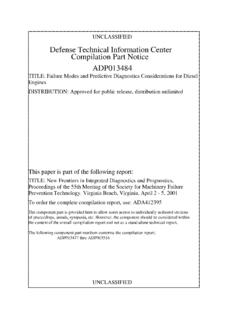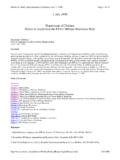Transcription of MILITARY MUNITIONS RULE (MR) DoD EXPLOSIVES …
1 MILITARY MUNITIONS RULE (MR). and DoD EXPLOSIVES safety board ( ddesb ). colonel J. C. King Chief, MUNITIONS Division Office of the Deputy Chief of Staff for Logistics Headquarters, Department of the Army The Requirement Section 107 of the Federal Facilities Act of 1992 required EPA. to publish rules that identify when MILITARY MUNITIONS (conventional and chemical) become solid waste and provide for the safe management of such waste. The Rule Development The Environmental Protection Agency (EPA), in consultation with DoD and state officials, developed the MILITARY MUNITIONS Rule (MR). After several meetings and proposals, the MR was provided for public comment. The EPA published the final rule with comments in the Federal Register on February 12, 1997.
2 The MR defined MILITARY MUNITIONS and identified when they become solid waste. The rule also provides for safe storage and transportation of waste MILITARY MUNITIONS (WMM). The MR is a Federal regulation implementing the Resource Conservation and Recovery Act, 40 CFR. Part 260 et al, and was effective on August 12, 1997. Also amended were existing regulations regarding emergency responses that involve both MILITARY and non- MILITARY MUNITIONS and EXPLOSIVES . The MR provides for two approaches for storing WMM - Permitted Subpart EE storage, and Conditional Exemption (CE). Subpart EE storage is RCRA permitted storage of hazardous WMM. Installations must permit the storage of all waste chemical MUNITIONS and conventional MUNITIONS not under CE.
3 Form Approved Report Documentation Page OMB No. 0704-0188. Public reporting burden for the collection of information is estimated to average 1 hour per response, including the time for reviewing instructions, searching existing data sources, gathering and maintaining the data needed, and completing and reviewing the collection of information. Send comments regarding this burden estimate or any other aspect of this collection of information, including suggestions for reducing this burden, to Washington Headquarters Services, Directorate for Information Operations and Reports, 1215 Jefferson Davis Highway, Suite 1204, Arlington VA 22202-4302. Respondents should be aware that notwithstanding any other provision of law, no person shall be subject to a penalty for failing to comply with a collection of information if it does not display a currently valid OMB control number.
4 1. REPORT DATE 3. DATES COVERED. 2. REPORT TYPE. AUG 1998 00-00-1998 to 00-00-1998. 4. TITLE AND SUBTITLE 5a. CONTRACT NUMBER. MILITARY MUNITIONS Rule (MR) and DoD EXPLOSIVES safety board 5b. GRANT NUMBER. ( ddesb ). 5c. PROGRAM ELEMENT NUMBER. 6. AUTHOR(S) 5d. PROJECT NUMBER. 5e. TASK NUMBER. 5f. WORK UNIT NUMBER. 7. PERFORMING ORGANIZATION NAME(S) AND ADDRESS(ES) 8. PERFORMING ORGANIZATION. REPORT NUMBER. Department of the Army,Office of the Deputy Chief of Staff for Logistics, MUNITIONS Division,Washington,DC,20301. 9. SPONSORING/MONITORING AGENCY NAME(S) AND ADDRESS(ES) 10. SPONSOR/MONITOR'S ACRONYM(S). 11. SPONSOR/MONITOR'S REPORT. NUMBER(S). 12. DISTRIBUTION/AVAILABILITY STATEMENT. Approved for public release; distribution unlimited 13.
5 SUPPLEMENTARY NOTES. See also ADM001002. Proceedings of the Twenty-Eighth DoD EXPLOSIVES safety Seminar Held in Orlando, FL on 18-20 August 1998. 14. ABSTRACT. 15. SUBJECT TERMS. 16. SECURITY CLASSIFICATION OF: 17. LIMITATION OF 18. NUMBER 19a. NAME OF. ABSTRACT OF PAGES RESPONSIBLE PERSON. a. REPORT b. ABSTRACT c. THIS PAGE Same as 5. unclassified unclassified unclassified Report (SAR). Standard Form 298 (Rev. 8-98). Prescribed by ANSI Std Z39-18. CE applies only to non-chemical WMM that are subject to the jurisdiction of the ddesb . The EPA determined that the ddesb . standards for the management of MILITARY MUNITIONS meet or exceed RCRA standards in virtually all respects. The applicability of these standards to WMM is the major reason for EPA's belief that under the conditions of the exemption it is not necessary to subject WMM to RCRA storage regulation.
6 CE. WMM may be on MILITARY installations or contractor facilities. Authorized states, states with EPA granted authorities to implement RCRA, must adopt CE before installations within that state can use CE. Alaska, Hawaii, Iowa, Puerto Rico, and Guam do not have implementation authority and CE is automatically available. Several states (Georgia, Mississippi, Alabama, Oklahoma, Nevada, Arizona, Oregon, and Idaho) have adopted CE. while others are considering it. Still others are waiting to see the complete DoD MR implementation policy before giving consideration to CE. The Partnering DoD developed a partnering initiative to involve states, several American Indian tribes, and environmental interest groups early in the policy development process.
7 The partnering group developed recommended language to cover gaps between RCRA. regulations and DoD , DoD Ammunition and EXPLOSIVES safety Standards. The Rule and The Standard EPA, in the development stage of MR, made a comparison between RCRA storage requirements and the DoD storage requirements for MILITARY MUNITIONS . One of the standards that EPA considered was DoD's Explosive safety Standards, DoD , which are founded in public law, Title 10, Section 172. EPA recognized the success of the DoD EXPLOSIVES safety board . It also recognized that the ddesb Standards for MUNITIONS storage were as stringent and protective of human health and the environment as the RCRA waste storage requirements, with a few exceptions.
8 In its review, EPA identified specific gaps ( , no requirements to coordinate with local authorities or storage unit closure requirements) between RCRA regulations and the ddesb Standard. The board Action With the partnering group's and other agencies' input, the ddesb . approved, at its 315th Meeting on January 21, 1998, several changes (Attachment 1) to DoD These included a new Chapter 14, Special Storage Procedures for Waste MILITARY MUNITIONS ; amendments to Chapter 8, Hazard Identification for Fire Fighting; and amendments to Chapter 12, Real Property Contaminated With Ammunition, EXPLOSIVES or Chemical Agents. A. "Notice of Change" to the Standard was published in the Federal Register March 23, 1998.
9 The board Changes The changes addressed the gaps between RCRA procedures and the Standard and institutionalized a process for closing a facility where ammunition and EXPLOSIVES were once stored. The new Chapter 14 included: * CE storage procedures. - Record maintenance - Physical separation of waste from non-WMM. - Marking WMM. - Storage facility standards of no waivers or exemptions of quantity-distance criteria - Standard operating procedures (SOPs) or plans to provide safety , security, and environment protection. The SOPs or plans have to be coordinated using the new requirements in chapter 8. * Conditions which will result in loss of CE. - Any unpermitted or uncontrolled detonation, release, discharge, or migration of WMM out of a storage unit including loss or theft - Withdrawn by Federal or state environmental regulatory authorities based on review or inspection of non- compliance with requirements - DoD Components may, at any time, restrict an activity from using CE.
10 * Actions to take when states' regulatory regulations conflict with ddesb or DoD Component EXPLOSIVES safety standards. * Reporting telephonically and in writing of any unpermitted or uncontrolled detonation, release, discharge, or migration of WMM out of any storage unit. * Closure of facilities under CE. - Notify appropriate federal or state environmental regulatory authority in writing at least 45 days before closure begins. - Upon completion of closure (see Chapter 12), prepare certificate of closure and submit to appropriate federal or state regulatory authority within 90 days of completing closure activities. * Closure of facilities under a RCRA permit. In addition to Chapter 12 process, comply with permit procedures.











